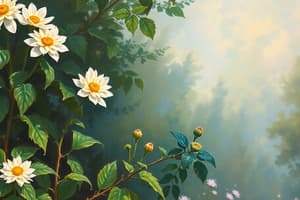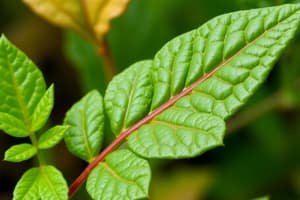Podcast
Questions and Answers
What is the process of pollination?
What is the process of pollination?
- The process of fruit formation in plants
- The process of transferring pollen from an anther to a stigma (correct)
- The process of photosynthesis in plants
- The process of seed germination in plants
What type of pollination occurs within the same plant?
What type of pollination occurs within the same plant?
- Cross-pollination
- Hybrid pollination
- Self-pollination (correct)
- Artificial pollination
Which of the following is an example of an abiotic agent of pollination?
Which of the following is an example of an abiotic agent of pollination?
- Wind (correct)
- Hummingbirds
- Bees
- Monkeys
What is the first step in the pollination process?
What is the first step in the pollination process?
What is the purpose of pollination?
What is the purpose of pollination?
Which type of pollination occurs between different plants?
Which type of pollination occurs between different plants?
What happens to the pollen grain during pollen germination?
What happens to the pollen grain during pollen germination?
What is the role of the stigma in the pollination process?
What is the role of the stigma in the pollination process?
What is the result of fertilization in the pollination process?
What is the result of fertilization in the pollination process?
What is necessary for fruit production?
What is necessary for fruit production?
What is the term for pollination by human intervention?
What is the term for pollination by human intervention?
What is the term for pollination by water?
What is the term for pollination by water?
Study Notes
Pollination Process
What is Pollination?
- The process of transferring pollen from the male reproductive organ of a plant (anther) to the female reproductive organ of the same or another plant (stigma)
- Allows for fertilization and reproduction in plants
Types of Pollination
- Self-Pollination
- Occurs when pollen from an anther is transferred to the stigma of the same flower or another flower on the same plant
- Common in plants that produce many flowers, such as roses and tomatoes
- Cross-Pollination
- Occurs when pollen from an anther is transferred to the stigma of a different plant
- Common in plants that produce few flowers, such as orchids and fruits
Agents of Pollination
- Biological Agents
- Insects (bees, butterflies, moths, wasps)
- Birds (hummingbirds, sunbirds)
- Bats
- Other animals (monkeys, lemurs)
- Abiotic Agents
- Wind (anemophily)
- Water (hydrophily)
Steps of Pollination
- Pollen Production
- Pollen grains are produced in the anther of a flower
- Pollen Dispersal
- Pollen grains are released from the anther and dispersed into the environment
- Pollen Collection
- Pollen grains are collected by a pollinator (insect, bird, etc.)
- Pollen Transfer
- Pollen grains are transferred to the stigma of another flower
- Fertilization
- Pollen grain germinates and fertilizes the ovule, resulting in seed formation
Importance of Pollination
- Food Production
- Many crops rely on pollination for reproduction (fruits, vegetables, nuts)
- Ecosystem Balance
- Pollination supports biodiversity and ecosystem health
Studying That Suits You
Use AI to generate personalized quizzes and flashcards to suit your learning preferences.
Description
Test your knowledge of the pollination process, including the different types of pollination, agents of pollination, and the importance of pollination in food production and ecosystem balance. Learn about the steps of pollination and how it supports plant reproduction and biodiversity.




